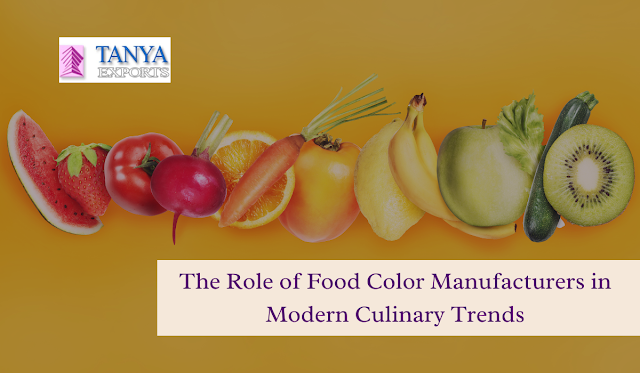The Role of Food Color Manufacturers in Modern Culinary Trends
In today’s culinary industry, visual appeal plays a significant role in consumer decisions. With the increasing focus on aesthetics, the vibrant hues of our meals are not just for decoration—they enhance the dining experience, stimulate appetites, and convey a sense of freshness and quality. As culinary trends evolve, food colour manufacturers in Ahmedabad have become essential players in shaping how we perceive and enjoy our meals. These producers have a profound impact on everything from packaging to the final product's appearance, and their innovations are driving trends in how we cook, eat, and interact with food.
The Science Behind Edible Tints
Edible
tints, whether derived from natural or synthetic sources, are responsible for
the shades we associate with different dishes. The world of edible tints is a
blend of art and science, as producers balance the need for vibrant, appealing
shades with safety and regulatory guidelines.
Ingredient
producers work to create dyes and pigments that can safely be incorporated into
a wide variety of items, from beverages to baked goods, sauces, and candies.
The use of these tints dates back to ancient times when natural sources like
fruits, vegetables, and spices were utilized. However, with the advancement of
modern food production, synthetic tints became more efficient and affordable.
Today,
there is a growing demand for coloring agents that align with contemporary
consumer values. Many producers are responding to the call for clean labels,
which emphasize natural and organic ingredients free of artificial additives.
This shift has led to a resurgence of naturally derived tints from sources like
beet juice, spirulina, and turmeric, enabling producers to meet consumer
expectations for both vibrant colors and ingredient transparency.
Meeting the Demand for Customization
As
culinary trends become more experimental, ingredient producers have had to
innovate to meet the growing demand for customization. Today’s consumers are
not satisfied with one-size-fits-all products. They want choices that suit
their individual tastes, dietary preferences, and ethical considerations.
Whether it’s vegan, gluten-free, or allergen-free products, the role of
ingredient producers is to create versatile and customizable colorants that
meet a variety of needs.
For
instance, many producers now offer customizable hues to match the specific
needs of chefs, restaurateurs, and product developers. Whether it’s for a
seasonal product line or a unique menu item, the ability to customize tints can
enhance the appeal of new dishes or limited-edition items. This growing trend
of personalized dining experiences highlights the creative possibilities in
food coloring and the ongoing importance of producers who can adapt to these
needs.
Additionally,
there has been a rising demand for vibrant shades that are used not just for
aesthetic purposes but also for functionality. For example, the use of tints to
indicate flavor or to highlight specific ingredients has grown in popularity.
Producers are increasingly able to create colors that communicate the taste
experience before the first bite, allowing brands to offer a more immersive
culinary experience for their customers.
The Influence of Social Media and Influencers
Social
media platforms like Instagram, Pinterest, and TikTok have accelerated the need
for visually appealing food products. Influencers and food bloggers are now the
trendsetters in the culinary world, and their colorful, eye-catching creations
often go viral, setting the stage for the next big culinary craze. From rainbow
cakes to colorful lattes, the role of ingredient producers in shaping these
trends is undeniable.
Producers
recognize that vibrant, Instagram-worthy dishes can lead to greater visibility
and demand. The pressure to create visually stunning meals that not only taste
good but look good on camera is driving the innovation of bright, bold food
tints. This is particularly evident in the rise of products like neon-colored
snacks, holographic beverages, and pastel desserts—all of which rely heavily on
specialized colorants.
For food colour manufacturers in India,
staying ahead of these trends means developing tints that remain stable in
various formats while also meeting the aesthetic demands of social media-savvy
consumers. As a result, colorants have become integral not only to flavor
profiles but also to visual branding strategies. This means producers are
constantly testing and refining their products to ensure they align with
rapidly changing preferences.
Sustainability and the Shift Toward Natural
Pigments
Another
major development in the food coloring industry is the growing emphasis on
sustainability. As consumers become more aware of the environmental impact of
their choices, there is an increasing preference for eco-friendly and
sustainable products. This trend has led many ingredient producers to explore
plant-based colorants, which are often derived from organic sources like
fruits, vegetables, and even algae.
The shift
toward natural coloring agents is also driven by concerns about synthetic dyes
and their potential health risks. Over the past few years, some artificial
colorants have faced increased scrutiny, with consumers seeking alternatives
that are perceived as safer and more natural. In response, ingredient producers
are investing in new, sustainable methods to extract vibrant pigments from
natural sources. For example, beetroot powder, butterfly pea flower extract,
and matcha are being used more frequently in a wide range of products, offering
both appealing colors and added nutritional benefits.
Conclusion
Ingredient producers play a pivotal role in modern culinary trends. By
innovating with new, safer, and more sustainable colorants, these producers
contribute to the dynamic and evolving industry. Whether it’s satisfying the
demand for natural and clean-label products, embracing social media trends, or
adapting to consumer preferences for customization, Food Colours Manufacturers are key
players in the broader landscape of food innovation. As trends continue to
evolve, one thing is clear: color will remain an essential tool in shaping the
way we experience meals, and the producers behind it will continue to lead the
way in culinary creativity.

.png)
.png)
.png)
Comments